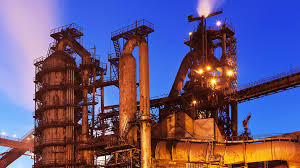Blast Furnace:

Tata Steel Ltd. recently said it had commissioned ‘India’s largest blast furnace’ at Kalinganagar, Odisha, as part of the Phase II expansion of its plant.
- Blast Furnace is a vertical shaft furnacethat produces liquid metals by the reaction of a flow of air introduced under pressure into the bottom of the furnace with a mixture of metallic ore, coke, and flux fed into the top.\
- The blast furnace itself is a steel shaft lined with fire resistant, refractory materials.
- The hottest part of the furnace – where the walls reach a temperature >300°C – is water-cooled.
- The whole structure is supported from the outside by a steel frame.
- Blast furnaces are used to produce pig iron from iron ore for subsequent processing into steel, and they are also employed in processing lead, copper, and other metals.
- The process is continuous, with raw materials being regularly charged to the top of the furnace and molten metal and slag being tapped from the bottom of the furnace at regular intervals.
- Once a blast furnace is started, it will continuously run for four to ten years with only short stops to perform planned maintenance.
- Rapid combustionis maintained by the current of air under pressure.
- Blast furnaces are the largest consumers of materials and energy in the iron and steel-making process.




